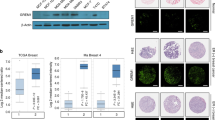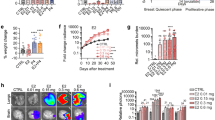Abstract
Grb2-associated binder 2 (Gab2) is a recently identified member of the Gab/Daughter of sevenless family of docking proteins, which localize, amplify and integrate signaling pathways activated by various receptors including receptor tyrosine kinases (RTKs). To date, Gab2 signaling has been primarily investigated in hematopoietic cells. Here we report marked overexpression of Gab2 in a subset of breast cancer cell lines relative to normal breast epithelial strains and a trend for increased Gab2 expression in estrogen receptor (ER)-positive lines. Overexpression relative to normal ductal epithelium was also observed in some primary breast cancers. In MCF-7 breast cancer cells Gab2 was markedly tyrosine phosphorylated in response to heregulin and also following EGF, insulin or bFGF administration, indicating that a variety of RTKs implicated in breast cancer development or progression couple to this docking protein. In hormone-responsive breast cancer cells, GAB2 mRNA and protein expression were induced by estradiol in a manner sensitive to the pure anti-estrogen ICI 182780, indicating that this regulation is mediated via the ER. Gab2 therefore represents a novel link between steroid and growth factor signaling in breast cancer, and when overexpressed, may modulate the sensitivity of breast cancer cells to these important growth regulators.
This is a preview of subscription content, access via your institution
Access options
Subscribe to this journal
Receive 50 print issues and online access
$259.00 per year
only $5.18 per issue
Buy this article
- Purchase on Springer Link
- Instant access to full article PDF
Prices may be subject to local taxes which are calculated during checkout




Similar content being viewed by others
References
Alexander IE, Clarke CL, Shine J, Sutherland RL . 1989 Mol. Endocrinol. 3: 1377–1386
Ali S, Coombes RC . 2000 J. Mam. Gland Biol. Neoplasia 5: 271–281
Allard JD, Chang HC, Herbst R, McNeill H, Simon MA . 1996 Development 122: 1137–1146
Bates SE, Davidson NE, Valverius EM, Freter CE, Dickson RB, Tam JP, Kudlow JE, Lippman ME, Salomon DS . 1988 Mol. Endocrinol. 2: 543–555
Buckley MF, Sweeney KJE, Hamilton JA, Sini RL, Manning DL, Nicholson RI, deFazio A, Watts CKW, Musgrove EA, Sutherland RL . 1993 Oncogene 8: 2127–2133
Campbell RA, Bhat-Nakshatri P, Patel NM, Constantinidou D, Ali S, Nakshatri H . 2001 J. Biol. Chem. 276: 9817–9824
Clarke R . 2000 J. Mam. Gland Biol. Neoplasia 5: 245–250
Cullen KJ, Lippman ME, Chow D, Hill S, Rosen N, Zwiebel J . 1992 Mol. Endocrin. 6: 91–100
Daly RJ, Harris WH, Wang DY, Darbre PD . 1991 Cell Growth Differ. 2: 457–464
Gu H, Maeda H, Moon JJ, Lord JD, Yoakim M, Nelson BH, Neel BG . 2000 Mol. Cell. Biol. 20: 7109–7120
Gu H, Pratt JC, Burakoff SJ, Neel BG . 1998 Mol. Cell 2: 729–740
Gu H, Saito K, Klaman LD, Shen J, Fleming T, Wang Y, Pratt JC, Lin G, Lim B, Kinet J-P, Neel BG . 2001 Nature 412: 186–190
Herbst R, Carroll PM, Allard JD, Schilling J, Raabe T, Simon MA . 1996 Cell 85: 899–909
Holgado-Madruga M, Emlet DR, Moscatello DK, Godwin AK, Wong AJ . 1996 Nature 379: 560–564
Hynes NE . 2000 Breast Cancer Res. 2: 154–157
Itoh M, Yoshida Y, Nishida K, Narimatsu M, Hibi M, Hirano T . 2000 Mol. Cell. Biol. 20: 3695–3704
Janes PW, Daly RJ, deFazio A, Sutherland RL . 1994 Oncogene 9: 3601–3608
Kameda H, Risinger JI, Han B-B, Baek SJ, Barrett JC, Abe T, Takeuchi T, Glasgow WC, Eling TE . 2001 Mol. Cell. Biol. 21: 6895–6905
Kato S, Endoh H, Masuhiro Y, Kitamoto T, Uchiyama S, Sasaki H, Masushige S, Gotoh Y, Nishida E, Kawashima H, Metzger D, Chambon P . 1995 Science 270: 1491–1494
Kouhara H, Hadari YR, Spivak-Kroizman T, Schilling J, Bar-Sagi D, Lax I, Schlessinger J . 1997 Cell 89: 693–702
Kurokawa H, Lenferink AEG, Simpson JF, Pisacane PI, Sliwkowski MX, Forbes JT, Arteaga CL . 2000 Cancer Res. 60: 5887–5894
Laborda J . 1991 Nucleic Acids Res. 19: 3998
Lai A, Sarcevic B, Prall OWJ, Sutherland RL . 2001 J. Biol. Chem. 276: 25823–25833
Lee AV, Jackson JG, Gooch JL, Hilsenbeck SG, Coronado-Heinsohn E, Osborne CK, Yee D . 1999 Mol. Endocrin. 13: 787–796
Lynch DK, Daly RJ . 2002 EMBO J. 21: 72–82
Migliaccio A, Di Domenico M, Castoria G, de Falco A, Bontempo P, Nola E, Auricchio F . 1996 EMBO J. 15: 1292–1300
Musgrove EA, Sutherland RL . 1993 Eur. J. Cancer 29A: 2273–2279
Prall OWJ, Rogan EM, Musgrove EA, Watts CKW, Sutherland RL . 1998 Mol. Cell. Biol. 18: 4499–4508
Prall OWJ, Sarcevic B, Musgrove EA, Watts CKW, Sutherland RL . 1997 J. Biol. Chem. 272: 10882–10894
Rocha RL, Hilsenbeck SG, Jackson JG, van den Berg CL, Weng C-N, Lee AV, Yee D . 1997 Clin. Cancer. Res. 3: 103–109
Rozakis-Adcock M, McGlade J, Mbamalu G, Pelicci G, Daly R, Li W, Batzer A, Thomas S, Brugge J, Pelicci PG, Schlessinger J, Pawson T . 1992 Nature 360: 689–692
Surmacz E, Burgaud J-L . 1995 Clin. Cancer. Res. 1: 1429–1436
Tzahar E, Waterman H, Chen X, Levkowitz G, Karunagaran D, Lavi S, Ratzkin BJ, Yarden Y . 1996 Mol. Cell. Biol. 16: 5276–5287
Weidner KM, Di Cesare S, Sachs M, Brinkman V, Behrens J, Birchmeier W . 1996 Nature 384: 173–176
Wolf I, Jenkins BJ, Liu Y, Seiffert M, Custodio JM, Young P, Rohrschneider LR . 2002 Mol. Cell. Biol. 22: 231–244
Yee D, Lee AV . 2000 J. Mam. Gland Biol. Neoplasia 5: 107–115
Yenush L, White M . 1997 Bioessays 19: 491–500
Zhao C, Yu D-H, Shen R, Feng G-S . 1999 J. Biol. Chem. 274: 19649–19654
Acknowledgements
This work was supported by the National Health and Medical Research Council of Australia, the Cancer Council New South Wales. NIH grants ca49152 and 66600 (to BG Neel) and an American Association for Cancer Research Fellowship (to H= Gu), ICI 182780 was a kind gift of Dr Alan Wakeling, AstraZeneca Pharmaceuticals, Alderley Park, Cheshire, UK.
Author information
Authors and Affiliations
Corresponding author
Rights and permissions
About this article
Cite this article
Daly, R., Gu, H., Parmar, J. et al. The docking protein Gab2 is overexpressed and estrogen regulated in human breast cancer. Oncogene 21, 5175–5181 (2002). https://doi.org/10.1038/sj.onc.1205522
Received:
Revised:
Accepted:
Published:
Issue Date:
DOI: https://doi.org/10.1038/sj.onc.1205522
Keywords
This article is cited by
-
USP35, regulated by estrogen and AKT, promotes breast tumorigenesis by stabilizing and enhancing transcriptional activity of estrogen receptor α
Cell Death & Disease (2021)
-
BRAF inhibition upregulates a variety of receptor tyrosine kinases and their downstream effector Gab2 in colorectal cancer cell lines
Oncogene (2018)
-
Changes in Gab2 phosphorylation and interaction partners in response to interleukin (IL)-2 stimulation in T-lymphocytes
Scientific Reports (2016)
-
Reverse-Phase Protein Array Analysis to Identify Biomarker Proteins in Human Pancreatic Cancer
Digestive Diseases and Sciences (2014)
-
Functional characterization of cancer-associated Gab1 mutations
Oncogene (2013)



